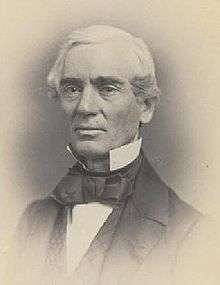Edwin B. Morgan

Edwin Barber Morgan (May 2, 1806 – October 13, 1881) was an entrepreneur and politician from the Finger Lakes region of western New York. He was the first president of Wells Fargo & Company, founder of the United States Express Company, and director of American Express Company. He was elected to the United States House of Representatives from New York and served for three terms.
Early life and education
Edwin Barber Morgan was born in Aurora, New York, the eldest son of Christopher and Nancy (Barber) Morgan. He was a first cousin of Edwin Denison Morgan, governor of New York in 1859–62. The family was descended from James Morgan, a Welshman who came to Massachusetts about 1636 and settled in New London, Connecticut about 1650.
Educated in the local schools, Morgan took over his father's mercantile business in 1827.
Marriage and family
On September 27, 1829, Morgan married Charlotte Fidelia Wood of Aurora. The couple were the parents of a son and a daughter.[1]
Career
Morgan soon established a large enterprise in buying and shipping agricultural products, and also in boat-building, in which he was joined by his brothers. With his brothers, he also had extensive gypsum beds at Grand Rapids, Michigan, and a starch-making business at Oswego, New York.[2]
He was a director and first president of Wells Fargo & Company, organized March 18, 1852, by his fellow townsman Henry Wells, who had first founded American Express in 1850 with two associates. Wells Fargo was developed specifically to offer express mail, shipping and banking services to California, where thousands of people were being drawn as the Gold Rush spurred migration and development.
In 1854 Morgan founded the United States Express Company to provide similar express mail services for the Southern states. It connected with Wells Fargo at St. Louis, Missouri.
Also, from about this time until his death in 1881, Morgan was a director of the American Express Company, which had been founded in Albany in 1850 to offer express mail and banking services throughout New York state. By the time Morgan became involved, American Express had its headquarters in Manhattan.[3][4]
Morgan was elected to Congress in 1852 as a Whig, in 1854 as an Opposition Party candidate, and in 1856 as a Republican. He represented New York's 25th congressional district from March 4, 1853 until March 3, 1859. In 1855–56 he was chairman of the Committee on Patents. Morgan was one of the Members of Congress who rescued Charles Sumner from the assault by Preston Brooks on May 22, 1856.[5]
Early in his Congressional service, Morgan resigned as president of Wells Fargo but remained a member of the board of directors. He was not a candidate for reelection in 1858. On July 20, 1858, he resigned his seat on the Wells Fargo board, and N.H. Stockwell was elected to succeed him. In November 1858, however, Thomas M. Janes resigned, and Morgan was again elected to the board.[6]
Later years
During the American Civil War, Morgan was active in raising and equipping regiments from New York, for which he received the title of colonel.
In the postwar period he became active with colleges. He was a trustee of Cornell University from 1865 until 1874. Working with his friend Henry Wells to found a college for women, he was a charter trustee of Wells College from 1868 until 1881, where he served as president of the board from 1878 onward. He was also a trustee of the Auburn Theological Seminary from 1870 to 1881. He supported the secondary school of Cayuga Lake Academy in Aurora as well.[7]
Morgan was a director of Wells Fargo until the beginning of 1867.[8] After a brief retirement, he was elected to the board in 1868 and served until 1870.[9]
An original shareholder of The New York Times, Morgan came to the paper's rescue in the midst of its fight against William Marcy Tweed in 1871. George Jones, the editor, feared that ownership of the paper would pass into unfriendly hands. For $375,000, Morgan purchased enough stock to avert this, and contributed materially to Tweed's eventual downfall.[10]
Morgan was physically and mentally quick-moving and incessantly active, even in old age. He died at Aurora on October 13, 1881, at the age of 75. Interment was at Oak Glen Cemetery in Aurora.
Notes
- ↑ Dictionary of American Biography, Vol. XIII, p. 168.
- ↑ Dictionary of American Biography, Vol. XIII, p. 167. New York: Charles Scribner's Sons, 1934.
- ↑ Dictionary of American Biography, Vol. XIII, p. 167.
- ↑ Noel M. Loomis, Wells Fargo, pp. 15–16, 113, 155. New York: Clarkson N. Potter, Inc.
- ↑ Dictionary of American Biography, op. cit.
- ↑ Loomis, pp. 42, 139.
- ↑ Dictionary of American Biography, op. cit.
- ↑ Loomis, pp. 189, 197.
- ↑ Loomis, pp. 201, 212, 215.
- ↑ Dictionary of American Biography, op. cit.
External links
- United States Congress. "Edwin B. Morgan (id: M000948)". Biographical Directory of the United States Congress.
| United States House of Representatives | ||
|---|---|---|
| Preceded by Thomas Y. Howe, Jr. |
Member of the U.S. House of Representatives from New York's 25th congressional district March 4, 1853 – March 3, 1859 |
Succeeded by Martin Butterfield |